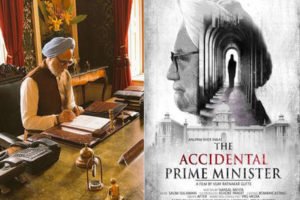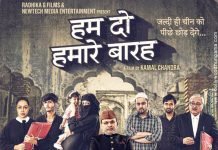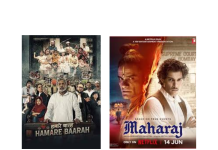*This post is has been primarily written by Arjun Narang, and has been updated by me. Arjun Narang is a 4th year student at the Jindal Global Law School. He is an avid mooter and loves to research. Arjun has represented his law school at the NLS Arbitration moot court competition, in the past, and is also in the team competing at the Oxford IP moot 2018-19. I would like to thank Arjun for his amazing inputs on a topic of such importance and relevance.
With recent row over the upcoming release of the much-awaited political drama, The Accidental PM, starring Anupam Kher, multiple petitions have been filed seeking a stay on the release of the rather controversial film. The film is said to be a biopic based on an adaptation of the memoirs of former Prime Minister Manmohan Singh’s Media Advisor, Sanjay Baru. The same has been referred to by the BJP as a ‘riveting tale of how a family held the country ransom for 10 years. Was Dr Singh just a regent who was holding on to the PM’s chair till the time heir was ready?’
In essence, claims seeking a ban on the release of the film suggest that the trailer shows the former PM as a victim of inside politics of the Congress party, ahead of the 2014 general elections, which the party lost. The contention is that the release would harm the image of the office of the prime minister, further, defaming the former prime minister and other senior leaders of the Congress party. Thereby, referring to the timing of the release as “a political stunt at the behest of some parties”, and calling it a “political propaganda with some other motives”, especially in light of the Lok Sabha elections just being a few months away, various petitions have been filed before various forums with the most recent one being before the apex court of India.
The following Petitions have reportedly been filed with the enlisted results:
- Sudhir Kumar Ojha (lawyer) filed before the Chief Judicial magistrate, Muzaffarpur, Bihar alleging hurtful and defamatory content. It was filed under IPC sections 295, 153, 153A, 293, 504 and 120B relating to insult with intent, promoting enmity between different groups. As reported, this case was to be heard by the Sub-divisional judicial magistrate on the 8th of January. Upon a hearing, an order was passed to register an FIR against Anupem kher and 13 other in this regard. This has been reported here.
- Delhi Based fashion designer, Pooja Mahajan, filed a petition before the Delhi High court seeking a stay on the broadcast of the trailer of the movie, on the ground of it having false and unauthorized impersonation and it “affecting and harming the reputation of the PMO”. This plea was dismissed by the Single Judge, Justice Vibhu Bakhru, who asked the petitioner to file a Public Interest Litigation instead. The order can be found here.
- As reported, a PIL had been filed by Pooja Mahajan in lieu of the above-mentioned decision before the Delhi HC, where the same allegations have been brought in along with a plea to quash the CBFC’s certificate which has been given to the film’s producers. This has been dismissed by the Division bench of the Delhi HC consisting of Chief Justice Rajendra Menon and Justice V.K.Rao on 9/1/19. As reported, they have held there to be no locus standi and involvement of pure private interest, which deny a cause of action in a PIL.
- As reported, a congress leader Anumit Singh Sodhi, filed a petition in the Punjab and Haryana high court, pleading for a stay on the broadcast of the trailer and the release of the movie “The Accidental Prime Minister”. This plea, although, was withdrawn during hearing and hence was dismissed as withdrawn by the HC on 9/1/19. This has been reported here.
- Finally, as reported, an appeal to the division bench decision of the Delhi HC has been filed by special leave to appeal, before the Hon’ble Supreme Court. This has been done by Pooja Mahajan. The appeal goes on the line of Section 416 of the Code (cheating) and states that “It is a known fact that film producers have not taken any consent/permission from Manmohan Singh, Sonia Gandhi and Rahul Gandhi to perform their characters or to perform their political life or to dress up in the same way as they had been doing in their normal life or to copy their voice in any manner.” Further, it has been claimed that “the film makers, producers have made an attempt to make commercial gains and the act of impersonation has been committed deliberately to defame the office of Prime Minister just to hype the excitement among the prospective viewers.” The plea also alleged that if the film will be released, friendly relations with the US and other foreign states were likely to be affected. As reported here, the Supreme Court has refused to grant an urgent hearing to the said appeal filed by Pooja Mahajan.
ARTISTIC FREEDOM OF SPEECH
In this article we will attempt to trace the right to artistic freedom of expression, as has been jurisprudentially interpreted in India and will analyse the same with respect to this issue.
A film under the constitution has a guarantee of protection under 19 (1)(a) and therefore a citizen has a right to exhibit films.[i] However it cannot be “absolutely” freely propagated in the market place due to its unique capacity to disturb and arouse feelings. Hence, it is required to be regulated or censored by the state.[ii] Article 19(2) lays down exceptions to the Freedom of speech and expression. These are exhaustive in nature and hence ought to be strictly construed.[iii] Therefore, censorship is permitted mainly under grounds specified under Article 19 (2) of the Constitution with emphasis on values and standards of society.[iv]
The court in K.A. Abbas v. Union of India[v] categorically upheld the freedom of artistic expression stating that, “It is also settled that freedom of speech and expression admits of extremely narrow restraints in case of clear and present danger…the censorship should be based on precise statement of what may not be subject-matter of film making and should allow full liberty to the growth of art and literature.” Further in Ramesh v. Union of India[vi], the Court opined, “Censors must make a substantial allowance in favour of freedom thus leaving a vast area for creative art to interpret life and society with some of its foibles along with what is good. A balance has to be struck.”
Recently, in Nachiketa Walhekar v. Central Board of Film Certification & Anr.,[vii] the court observed that,
“Be it noted, a film or a drama or a novel or a book is a creation of art. An artist has his own freedom to express himself in a manner which is not prohibited in law and such prohibitions are not read by implication to crucify the rights of expressive mind. The human history records that there are many authors who express their thoughts according to the choice of their words, phrases, expressions and also create characters who may look absolutely different than an ordinary man would conceive of. A thought provoking film should never mean that it has to be didactic or in any way puritanical. It can be expressive and provoking the conscious or the sub-conscious thoughts of the viewer. If there has to be any limitation, it has to be as per the prescription in law.”
The courts in the past have attempted to not interfere in matters where the expert body, i.e. the Central Board of Film Certification has granted a certificate to a certain film under Section 5A of the Indian Cinematograph Act, 1952. The Supreme Court in Union of India v. K.M. Shankarappa[viii] has opined that – the role of the board is that of a quasi-judicial body to decide the effect of a cinematographic film on the public and therefore its decision shall be final and binding upon at least the Executive and the Government.
The Courts are bound to a great extent by the decisions of the Board with regard to reasonable restrictions imposed on the freedom of speech and expression under 19(2) based on social interests. However, the restriction based on the ground of defamation can be considered tricky in some sense due to the private nature of such loss of reputation.
The Patna High Court in the case of Asha Parekh and Ors. v. The State Of Bihar,[ix] wherein the film was said to defame lawyers as a class held that- certification by the CBFC cannot be considered a complete defence to defamation and merely created a rebuttable presumption in the favour of the accused.
Therefore, what becomes pertinent in the present matter is whether the depiction of the former Prime Minister and the senior members of the congress party can be considered defamatory or derogatory depiction of them. The Delhi High Court in the Case of Sampat Pal vs Sahara One Media and Entertainment,[x] dealt with the issue of the release of the movie ‘Gulaab Gang’, wherein the plaintiff contended that the film depicts her life and organisation that she has built in a defamatory light and therefore while granting an injunction held, that, “The defendants, in case, they make a film on an individual’s life or an organization have to be careful in making the film that it is not derogatory or defamatory. If the defendants make a film depicting someone in a negative character/role the defendants take the risk and responsibility of the same.”
With relation to the particular case at hand, it is interesting to note the case of Ujjwal Anand Sharma v. UOI[xi]. This case dealt with the movie “Indu Sarkar” and the case, similar to one before us was alleged to be against public order and covered under the restrictions mentioned in Article 19(2). It was claimed that the film was falsifying the image of the congress ideologies and would arouse the feelings of congress supporters, making it an issue of maintenance of public order. It was held by the court that the grievance pleaded here would be a very personal matters to the people associated directly and locus standi in a PIL would be tough to make out. Further, it was held that the movie’s making was in public domain and the trailer had also released at an early stage, where no objection was taken. Because of the amount of money spent on the movie, a claim of delay in action may sustain. Further, it was held that the allegations were admittedly and solely based on the trailer and the film had already been approved by various statutory bodies and hence interference by the court on the same is not warranted for.
A similar view in our opinion might rest in this case as well as far as the claim to freedom of speech and expression is made out, as it is a strictly personal depiction and a public action is not warranted for in the form of a PIL. Further the onus to prove harmful content (under 19(2) for a writ to succeed) is on a higher pedestal due to the statutory authorization. Merely an inference and a ban on release due to the trailer may not be a feasible view to be taken by the Court and will go against the concept of artistic freedom of speech and expression under Article 19(1) (a).
Further, another interesting judgment to note in the present matter is Shivaji Rao Gaikwad vs M/S.Varsha Productions[xii], wherein Rajnikanth had moved to the Madras High Court for an injunction against the producers and directors of the movie ‘Main Hoon Rajnikanth’ for breach of his personality rights by the use of the same without his permission. In the matter the court held that, “if any person uses the name of a celebrity without his/her permission, the celebrity is entitled for injunction, if the said celebrity could be easily identified by the use of his name by the others…even assuming for a moment that the impugned movie is not a biopic of the plaintiff, since the name found in the title of the impugned movie is identifiable only with the plaintiff, who happens to be a celebrity and not with any other person, the defendant is not entitled to use the said name without the permission of the plaintiff/celebrity.”
Hence, in accordance with this, if a suit is specifically filed upon by the person who has been impersonated specifically, a claim maybe maintainable as the use is not for expressive or reporting purpose in public interest, rather solely for a commercial purpose. This however cannot be claimed by a third party.
However, it will be interesting to see if the people named in the film petition the courts for an injunction and therefore stall the release based on protection of their right to reputation and other personality rights invoking an action of defamation.
[i] Odyssey Communications Pvt. Ltd. v. Lokvidayan Sanghatana and Ors (1988) 3 SCC 410
[ii] S. Rangarajan v. P. Jagjivan Ram (1989) 2 SCC 574
[iii] Sakal Papers (P) Ltd. v. Union of India (1962) AIR 1962 SC 305
[iv]S. Rangarajan v. P. Jagjivan Ram (1989) 2 SCC 574
[v] AIR 1971 SC 481
[vi] 1988 AIR 775
[vii] W.P. (C) No. 1119 of 2017
[viii] 2000 (7) SCALE 659
[ix] 1977 CriLJ 21
[x] CS(OS) 638/2014
[xi] W.P.(C) 6408/2017
[xii] Civil Suit No.598 of 2014
Image source: here

















